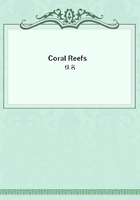
第42章
MILLEPORA, a strong coral with cylindrical branches, of a pink colour, about two inches high, resembling in the form of its orifices M. aspera of Lamarck, 94 and 30, E. Chiloe 43, Tierra del Fuego 53.
CORALIUM, 120, Barbary 33 N., Peyssonel in paper read to Royal Society May 1752.
ANTIPATHES, 16, Chonos 45.
GORGONIA (or an allied form), 160, Abrolhos on the coast of Brazil 18, Captain Beechey informed me of this fact in a letter.
Ellis ("Nat. Hist. of Coralline," page 96) states that Ombellularia was procured in latitude 79 deg N. STICKING to a LINE from the depth of 236 fathoms; hence this coral either must have been floating loose, or was entangled in stray line at the bottom. Off Keeling atoll a compound Ascidia (Sigillina) was brought up from 39 fathoms, and a piece of sponge, apparently living, from 70, and a fragment of Nullipora also apparently living from 92 fathoms. At a greater depth than 90 fathoms off this coral island, the bottom was thickly strewed with joints of Halimeda and small fragments of other Nulliporae, but all dead. Captain B. Allen, R.N., informs me that in the survey of the West Indies it was noticed that between the depth of 10 and 200 fathoms, the sounding lead very generally came up coated with the dead joints of a Halimeda, of which he showed me specimens. Off Pernambuco, in Brazil, in about twelve fathoms, the bottom was covered with fragments dead and alive of a dull red Nullipora, and I infer from Roussin's chart, that a bottom of this kind extends over a wide area. On the beach, within the coral-reefs of Mauritius, vast quantities of fragments of Nulliporae were piled up. From these facts it appears, that these simply organized bodies are amongst the most abundant productions of the sea.)
Although the limit of depth, at which each particular kind of coral ceases to exist, is far from being accurately known; yet when we bear in mind the manner in which the clumps of coral gradually became infrequent at about the same depth, and wholly disappeared at a greater depth than twenty fathoms, on the slope round Keeling atoll, on the leeward side of the Mauritius, and at rather less depth, both without and within the atolls of the Maldiva and Chagos Archipelagoes; and when we know that the reefs round these islands do not differ from other coral formations in their form and structure, we may, I think, conclude that in ordinary cases, reef-building polypifers do not flourish at greater depths than between twenty and thirty fathoms.
It has been argued ("Journal of the Royal Geographical Society," 1831, page 218.) that reefs may possibly rise from very great depths through the means of small corals, first making a platform for the growth of the stronger kinds. This, however, is an arbitrary supposition: it is not always remembered, that in such cases there is an antagonist power in action, namely, the decay of organic bodies, when not protected by a covering of sediment, or by their own rapid growth. We have, moreover, no right to calculate on unlimited time for the accumulation of small organic bodies into great masses. Every fact in geology proclaims that neither the land, nor the bed of the sea retain for indefinite periods the same level. As well might it be imagined that the British Seas would in time become choked up with beds of oysters, or that the numerous small corallines off the inhospitable shores of Tierra del Fuego would in time form a solid and extensive coral-reef.